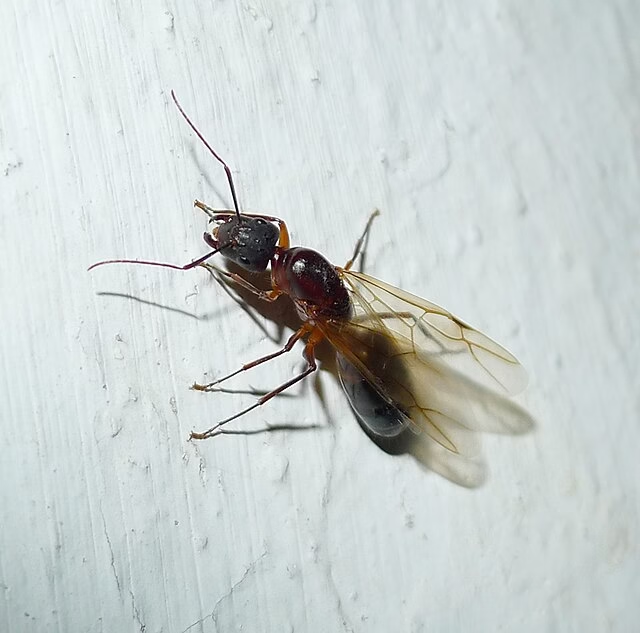Ant colony growth stages don’t happen overnight. Ant keeping is a game of patience, and understanding each phase will help you support your colony at every step.
In this guide, we’ll break down the four key growth stages of an ant colony:
✅ Founding Stage – The queen’s solo survival phase.
✅ Nanitic Stage – The first workers emerge and start foraging.
✅ Growth Phase – The colony expands in size and efficiency.
✅ Mature Colony – Thousands of workers, multiple queens (for polygynous species), and full nest expansions.
Let’s dive into how your tiny ant empire will take shape! 🐜🚀
1. The Founding Stage (0-8 Weeks After Capture)
👑 The Queen’s Survival Test
The founding stage is the most crucial time for a colony—it’s also when many beginners make mistakes by checking on the queen too much or trying to feed claustral species (who don’t need food yet!).
What Happens?
✔ The queen lays her first batch of eggs (usually within 1-2 weeks).
✔ She feeds the larvae from her own body reserves (if she’s fully claustral).
✔The pupae develop, and within 4–8 weeks, the colony’s first workers—called nanitics—emerge to support the queen.
Your Role as an Ant Keeper:
✔ Leave the queen alone—too much disturbance can stress her into eating her eggs. Read more on handling new queens here.
✔ Provide a constant water source (test tube setup). Learn the proper test tube setup.
✔ Do not feed fully claustral queens (e.g., Camponotus, Iridomyrmex, Pheidole).
✔ Semi-claustral queens (Myrmecia, Rhytidoponera) need occasional protein—place a tiny drop of honey and a small insect on foil inside the test tube.
🚀 Pro Tip: If the queen hasn’t laid eggs after 3-4 weeks, double-check her environment—temperature, vibrations, and light exposure all affect egg-laying.
2. The Nanitic Stage (8-12 Weeks After Capture)
🐜 The First Generation of Workers
The ant colony growth stages really kick off here, as nanitics start foraging and supporting the queen. Once the first workers (nanitics) emerge, the colony truly begins. These tiny, underdeveloped workers aren’t the strongest, but they’re critical for the queen’s survival.
What Happens?
✔ Nanitics begin foraging, cleaning, and taking on essential colony duties.
✔ The queen stops leaving the nest (unless it’s an exception like some Bull Ants).
✔ The colony’s food intake increases significantly.
Your Role as an Ant Keeper:
✔ Begin feeding the colony—small amounts of sugar (honey water) and protein (pre-killed insects). See the complete feeding guide.
✔ Keep food outside the test tube to avoid mould growth.
✔ Minimise vibrations and movement—nanitics are fragile and panic easily.
🚀 Pro Tip: If your nanitics ignore protein, try a smaller prey size (fruit flies work well). If they still ignore food, wait a few days—sometimes they need time to adjust.
3. The Growth Phase (3-12 Months In)
📈 Colony Expansion Begins
Once the second generation of workers arrives, the colony enters an explosive growth phase. Workers are larger, stronger, and more efficient at foraging and nest maintenance.
What Happens?
✔ The colony population increases rapidly.
✔ Foraging activity becomes more organised—ants create pheromone trails to food sources.
✔ The nest may start to feel cramped, leading to a need for expansion.
Your Role as an Ant Keeper:
✔ Increase food supply to support growing larvae (protein is essential).
✔ Keep an eye on hydration levels—more workers = more demand for water.
✔ Monitor space—if workers start piling on top of each other, it might be time to upgrade. Learn when to move them to a formicarium.
🚀 Pro Tip: If you see workers carrying pupae around constantly, it could be a sign the nest is too dry or crowded—adjust accordingly.
4. The Mature Colony (1+ Years In)
🏰 The Empire is Built
After a year (or more), your colony should have hundreds to thousands of workers, a well-established nest, and constant foraging activity.
What Happens?
✔ The colony runs efficiently, with different castes handling specific roles.
✔ Some species begin producing reproductive alates (future queens & males).
✔ Some polygynous species (like Pheidole and Iridomyrmex) may accept additional queens to boost numbers.
Your Role as an Ant Keeper:
✔ Expand the nest when needed—large colonies require more space to avoid stress.
✔ Adjust diet based on activity levels—more ants = more food.
✔ Prepare for hibernation (if required)—some species slow down during winter.
🚀 Pro Tip: If your ants start producing winged males and queens, it means they’re ready to spread—Unless you want alates flying around your room, now’s the time to upgrade to a securely contained setup.

Do All Ants Follow These Ant Colony Growth Stages?
Most ant species follow these four stages, but there are exceptions:
❌ Semi-claustral queens (Myrmecia, Rhytidoponera) require food even in the founding stage.
❌ Multi-queen species (Pheidole, Iridomyrmex) may accept multiple queens, leading to faster colony growth.
❌ Colony-founding theft – Some species steal brood from other colonies (Polyergus, some Myrmecia).
Understanding your species’ unique behaviour will help you manage the different ant colony growth stages more effectively.
For more on ant species behaviours and classifications, check out the Atlas of Living Australia.
Final Thoughts on Ant Colony Growth Stages: Patience is Key
Ant keeping isn’t an instant gratification hobby—colonies take months (or even years) to fully develop. But with the right knowledge and patience, you’ll witness one of nature’s greatest engineering marvels up close.
✔ Founding stage: The queen establishes the colony.
✔ Nanitic stage: First workers appear and begin foraging.
✔ Growth phase: Rapid population expansion.
✔ Mature colony: Full-scale operation with thousands of workers.
🐜 Enjoy the process, and watch your tiny empire grow! 🏰🚀
